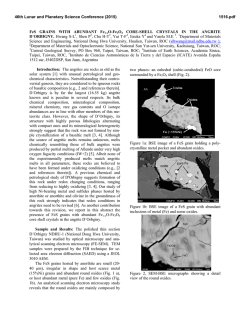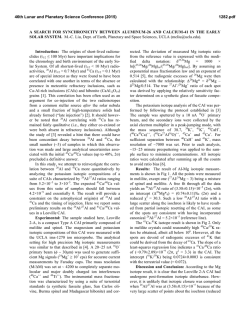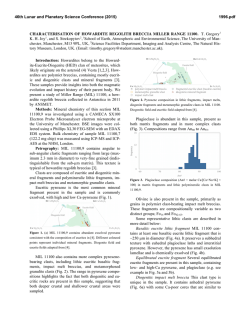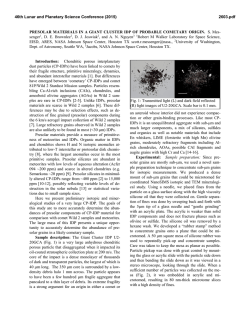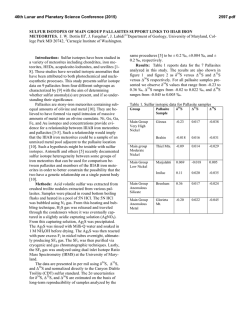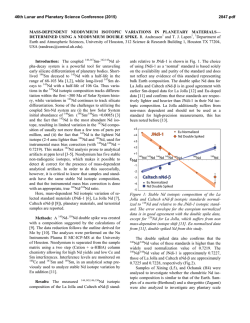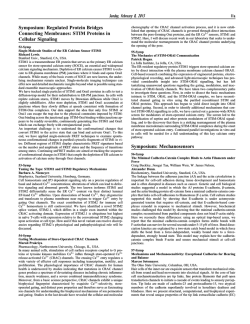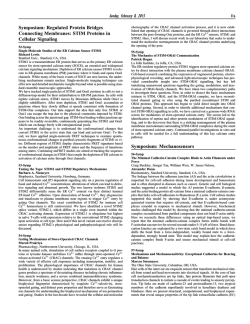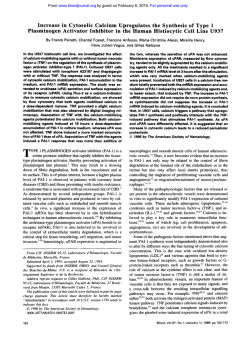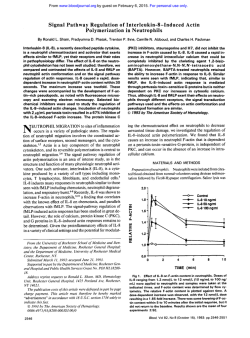
Early Solar System Alkali Fractionation Events - USRA
46th Lunar and Planetary Science Conference (2015) 1695.pdf EARLY SOLAR SYSTEM ALKALI FRACTIONATION EVENTS RECORDED BY K-Ca ISOTOPES IN THE Yamato-74442 LL-CHONDRITIC BRECCIA. Tatsunori Yokoyama1 K. Misawa2,3, O. Okano4, C.-Y. Shih5, L.E. Nyquist6, J.I. Simon6, M.J. Tappa5,6,7, S. Yoneda1. 1Natl Museum Nature & Sci., 4-1-1 Amakubo, Tsukuba, 3050005, Japan ([email protected]), 2Natl Inst. Polar Res., 3SOKENDAI, 10-3 Midoricho, Tachikawa, Tokyo, 190-8518, Japan ([email protected]), 4Graduate School of Natural Sci. & Tech., Okayama Univ., 3-1-1 Tsushimanaka, Okayama, 700-8530, Japan, 5Jacobs, NASA Johnson Space Center, Mail Code XI3, Houston, TX 77058, U.S.A., 6Astromaterials Res. & Exploration Sci., NASA-JSC, 2101 NASA Parkway, Houston, TX 77058-3696, U.S.A., 7Aerodyne Industries – Jacobs JETS Contract, NASA Johnson Space Center, Houston, TX 77058, U.S.A. Introduction: Radiogenic ingrowth of 40Ca due to decay of 40K occurred early in the solar system history causing the 40Ca abundance to vary within different early-former reservoirs. Marshall and DePaolo [1,2] demonstrated that the 40K-40Ca decay system could be a useful radiogenic tracer for studies of terrestrial rocks. Shih et al. [3,4] determined 40K-40Ca ages of lunar granitic rock fragments and discussed the chemical characteristics of their source materials. Recently, Yokoyama et al. [5] showed the application of the 40K-40Ca chronometer for high K/Ca materials in ordinary chondrites (OCs). High-precision calcium isotopic data are needed to constrain mixing processes among early solar system materials and the time of planetesimal formation. To better constrain the solar system calcium isotopic compositions among astromaterials, we have determined the calcium isotopic compositions of OCs and an angrite. We further estimated a source K/Ca ratio for alkali-rich fragments in a chondritic breccia using the estimated solar system initial 40Ca/44Ca. Experimental: Whole-rock samples of Yamato(Y-) 74442 (LL4), Bhola (LL3–6), Peace River (L6), Leedey (L6), Shaw (L6/7), Zhaodong (L4), Guangrao (L6) and D’Orbigny (angrite) were analyzed for calcium isotopes. Calcium was separated from other major elements using a polyethylene column filled with 1 mL cation exchange resin (BioRad AG50W-X8, 200–400 mesh) and was further purified using a quartz column filled with 200 µL Eichrom DGA resin (particle size: 50–100 µm) to remove titanium and aluminum. The calcium isotopic data were obtained on a multicollector thermal ionization mass spectrometer, Thermo Scientific Triton Plus at the National Museum of Nature and Science. Instrumental mass fractionation was corrected using the exponential law with 42Ca/44Ca = 0.31221 as the normalizing ratio [6]. Results and Discussion: After internal normalization, 26 measurements of calcium standard, NIST SRM915a yield 40Ca/44Ca = 47.1646 ± 0.0044 (2σp). Here, we report 40Ca/44Ca measurements for other samples normalized to the NIST SRM 915a, i.e., ε40Ca = [(40Ca/44Ca)sample/(40Ca/44Ca)SRM915a – 1] x 104. We plot ε40Ca for seven OCs and D’Orbigny with the internal uncertainties as 2σm (Fig. 1). The K/Ca ratios of OCs vary from 0.053 to 0.071. D’Orbigny is depleted in volatile elements (K/Ca = 0.00064 [7]). Hans et al. [8] reported strontium isotopic compositions of angrites, and suggested that volatile loss from the angrite parent body (APB) occurred within <1 Ma after formation of Ca, Al-rich inclusions. If this is the case, calcium isotopic compositions of the APB (i.e. quenched angrite, D’Orbigny) could be primordial, and represent isotopic compositions of early accreted materials. The OCs analyzed here (except Y-74442 and Bhola breccias) have ε40Ca values (–0.5 ± 0.2 ε-units; 4.563 Ga age corrected) that are slightly larger than the ε40Ca value of D’Orbigny (–1.0 ± 0.2 ε; age-corrected), implying that the initial 40Ca/44Ca ratio of APB is lower than those of OC parent bodies. Mixing of a chondritic component with an alkali-rich component formed in the early solar nebula [9] would have modified the age corrected ε40Ca values for Y-74442 and Bhola. Alternatively, some early solar system material remained heterogeneous in ε40Ca such that observed in Dhajala (H3.8) (+ 1.7 ε) [10,11]. The K/Ca ratio of the source of alkali-rich fragments can be estimated using the more precise Rb-Sr age of 4.420 Ga [5]. We obtain an age-corrected initial 40 Ca/44Ca ratio of 47.1621 ± 0.0009 using the presentday 40Ca/44Ca values of the fragments, which is within uncertainty of the initial 40Ca/44Ca ratio obtained from the y-intercept (Fig. 2). Using the initial 40Ca/44Ca value of the D’Orbigny angrite at 4.563 Ga, a source K/Ca value of 0.44 ± 0.18 for the Y-74442 fragments is obtained (Fig. 3), although the associated error is slightly large due to the narrow range of 40K/44Ca ratios. If we adopt this value as the source K/Ca value for the Y74442 alkali-rich fragments, it is seven times larger than that of the LL-chondrite parent body (K/Ca = 0.061 [12]). The results are generally consistent with the RbSr systematics of the fragments [9], and suggest that the potassium enrichment may have also occurred in the early solar system. If calcium and strontium contents in the parental melt at 4.420 Ga are chondritic, a K/Rb ratio of the precursor material is calculated to be ~170, which is approximately thirty percent less than that of the LLchondrite ((K/Rb)LL = 255 [12]) or CI ((K/Rb)CI = 235 46th Lunar and Planetary Science Conference (2015) 1695.pdf [13]) values. This indicates that mutual fractionations (i.e. an enrichment of heavier alkalis) could have occurred during the formation of the alkali-rich component (via alkali enrichment on a planetesimal or by early nebular condensates [9]). Abundance ratios of potassium and rubidium for the Y-74442 fragments are fairly constant [(K/Rb)fragments = 41–79], suggesting that further enrichments of rubidium (and possibly cesium) over potassium may have occurred just after a mixing event [9]. Figure 1. 40Ca/44Ca results, normalized to 42Ca/44Ca = 0.31221 [6], for seven OCs and D’Orbigny (solid symbols, errors are 2σm). Assuming OC parent bodies formed contemporaneously with the APB at 4.563 Ga [16], age corrected ε40Ca values are calculated from the present-day 40Ca/44Ca and K/Ca values of the whole-rock samples (open symbols). The correction for in situ 40K decay for D’Orbigny is insensitive to the age assumed. Figure 2. Potassium-calcium isochron diagram for alkalirich igneous rock fragments in Y-74442 [5]. Thirteen data points define a linear array corresponding to a K-Ca age of 4.42 ± 0.28 Ga (95% C.L., MSWD = 9.5) for λ(40K) = 0.5543 Ga–1 [14] using the Isoplot/Ex program [15]. Bhola (LL3–6) fragment ,1806-2 (solid square, blue) is plotted for comparison. Figure 3. Initial 40Ca/44Ca (ICa) versus age (T) for alkalirich fragments in Y-74442. We used the more reliable RbSr age of 4.420 Ga [5] as a crystallization age of the fragments, and obtained an initial 40Ca/44Ca ratio of 47.1597 ± 0.0009 by back calculations from the present-day 40Ca/44Ca and K/Ca values of the fragments. Lines represent the K/Ca growth curves. A time-averaged K/Ca value for the source of the Y-74442 fragments is calculated to be 0.44 ± 0.18 for the D’Orbigny initial 40Ca/44Ca ratio of 47.1599 (K = 69 ppm and Ca = 10.72% [7]) and the crystallization age of 4.563 Ga [16]. A large enrichment of potassium is required during the formation of the fragments. Radiogenic ingrowths of 40Ca/44Ca in CI- and LLchondrites and Earth’s mantle are shown for comparison. References: [1] Marshall, B.D., DePaolo, D.J. (1982) GCA 46, 2537–2545. [2] Marshall, B.D., DePaolo, D.J. (1989) GCA 53, 917–922. [3] Shih, C.-Y. et al. (1993) GCA 57, 915– 931. [4] Shih, C.-Y. et al. (1994) GCA 58, 3101–3116. [5] Yokoyama, Tatsunori et al. (2013) LPSC 44, #1972. [6] Russell, W.A. et al. (1978) GCA 42, 1075–1090. [7] Mittlefehldt, D.W. et al. (2002) MAPS 37, 345–369. [8] Hans, U. et al. (2013) EPSL 374, 204–214. [9] Yokoyama, Tatsunori et al. (2013) EPSL 366, 38–48. [10] Simon, J.I. et al. (2009) ApJ 702, 707–715. [11] Moynier, F. et al. (2010) ApJL 718, L7– 13. [12] Wasson, J.T., Kallemeyn, G.W. (1988) Phil. Trans. R. Soc. Lon. A, 325, 535–544. [13] Lodders, K. et al. (2009) In Landolt-Bornstein, New Series, Vol. VI/4B, Chap. 4.4, (ed. J.E. Trümper), Springer-Verlag, pp. 560–630. [14] Steiger, R.H., Jäger, E. (1977) EPSL 36, 359–362. [15] Ludwig, K.R. (2009) Spec. Publ., vol. 2, Berkeley Geochronol. Cent., Berkley, CA, U.S.A. [16] Brennecka, G.A., Wadhwa, M. (2012) PNAS 109, 9299–9303. Acknowledgements: We would like to thank Katsuyuki Yamashita of Okayama Univ. for supply of the D’Orbigny sample.
© Copyright 2026
